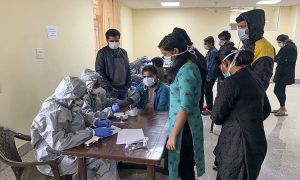Scientists had already determined that the variant of the novel coronavirus first detected in the fall in the United Kingdom – known as B.1.1.7. because of its molecular makeup – was probably 30 to 70 percent more transmissible than the typical version of the virus causing covid-19.
The variant is “associated with an increased risk of hospitalization and death compared to infection with” other forms of the virus, according to the study, which drew from multiple databases across the country.
There are still many unknowns: The data available to study has noteworthy gaps among critical demographics, such as nursing homes, and provides an incomplete tally of infections, a problem that has persisted throughout the pandemic.
But it does underscore how even – with efforts to fast-track fighting the virus – scientific data takes time to – gather and access, despite the pressing need for information.
first reported – and the weeks since British Prime Minister Boris Johnson initially said it appeared to be deadlier – the highly transmissible form of the virus has spread to more than 80 countries, including the United States, and become the dominant strain in some parts of Britain.
It has led to overwhelmed hospitals, disrupted travel and business, and necessitated a return to lockdowns in cities across Europe, even as coronavirus vaccination programs roll out to inoculate millions of people.
Scientists sequencing the virus have also detected several other highly transmissible variants, such as one that was first documented in South Africa.
Viruses constantly change through mutation, and new variants of a virus are expected to occur over time. Sometimes new variants emerge and disappear.
Other times, new variants emerge and persist. Multiple variants of the virus that causes COVID-19 have been documented in the United States and globally during this pandemic. The virus that causes COVID-19 is a type of coronavirus, a large family of viruses.
Coronaviruses are named for the crown- like spikes on their surfaces. Scientists monitor changes in the virus, including changes to the spikes on the surface of the virus. These studies, including genetic analyses of the virus, are helping scientists understand how changes to the virus might affect how it spreads and what happens to people who are infected with it.
The United Kingdom (UK) identified a variant called B.1.1.7 with a large number of mutations in the fall of 2020. This variant spreads more easily and quickly than other variants. In January 2021, experts in the UK reported that this variant may be associated with an increased risk of death compared to other variant viruses, but more studies are needed to confirm this finding.
It has since been detected in many countries around the world. This variant was first detected in the US at the end of December 2020. In South Africa, another variant called B.1.351 emerged independently of B.1.1.7. Originally detected in early October 2020, B.1.351 shares some mutations with B.1.1.7. Cases caused by this variant have been reported in the US at the end of January 2021.
In Brazil, a variant called P.1 emerged that was first identified in travelers from Brazil, who were tested during routine screening at an airport in Japan, in early January. This variant contains a set of additional mutations that may affect its ability to be recognized by antibodies. This variant was first detected in the US at the end of January 2021.
These variants seem to spread more easily and quickly than other variants, which may Ilead to more cases of COVID- 19. An increase in the number of cases will put more strain on health care resources, lead to more hospitalizations, and potentially more deaths.
So far, studies suggest that antibodies generated through vaccination with currently authorized vaccines recognize these variants. This is being closely investigated and more studies are underway.
IND SAMACHAR NEWS




























 WhatsApp us
WhatsApp us